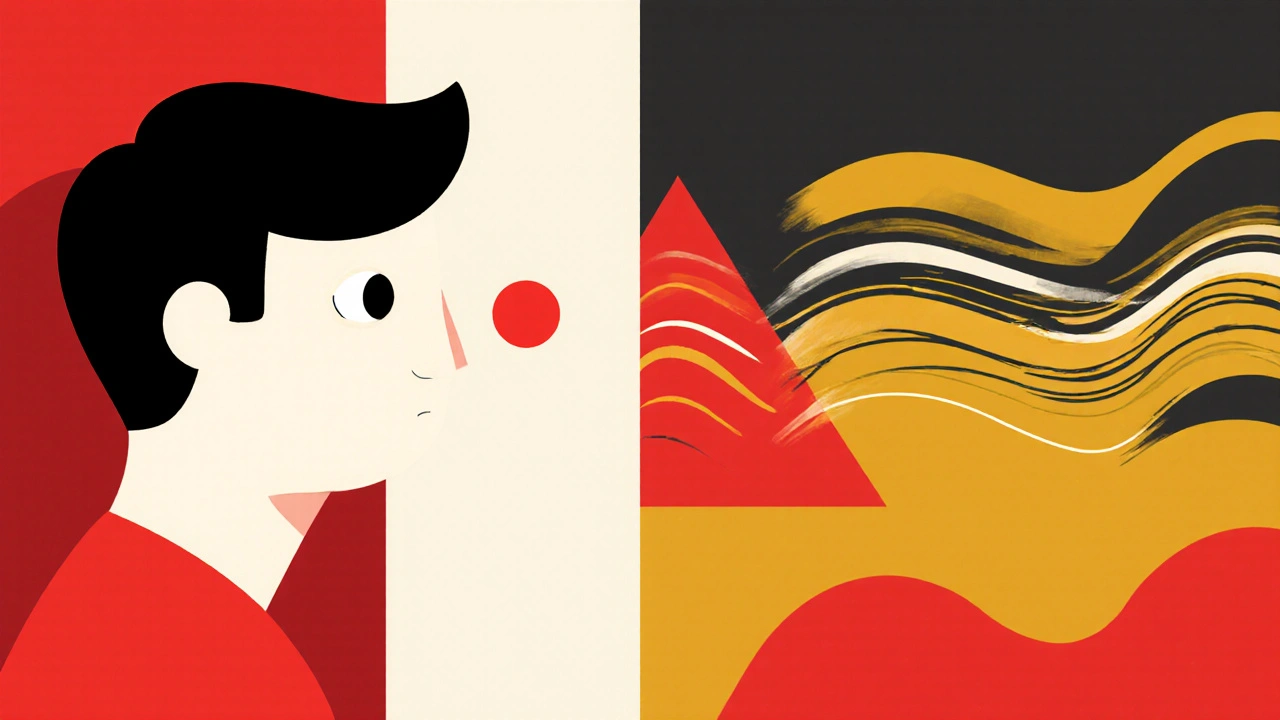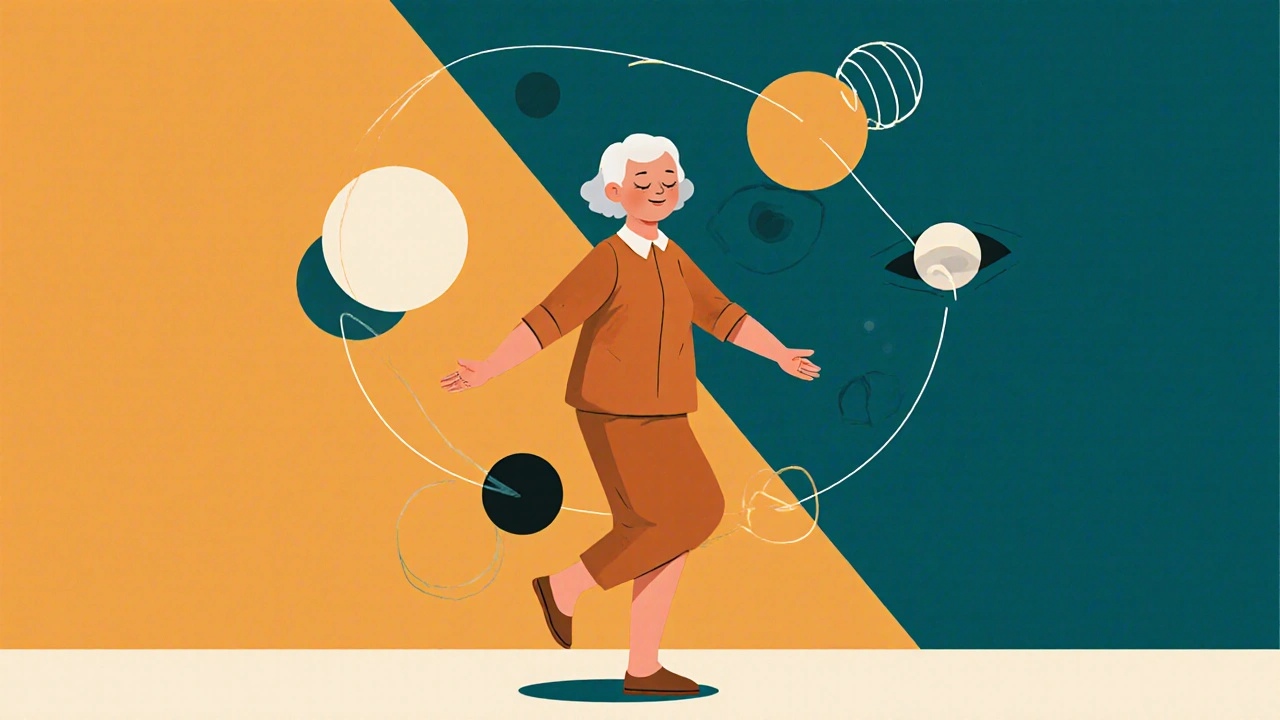Why You Keep Losing Your Balance (And What You Can Do About It)
If you’ve ever felt like the floor tilted beneath you, or got dizzy just turning over in bed, you’re not alone. One in three adults over 65 falls each year. For many, it’s not bad luck-it’s a sign their vestibular system isn’t working right. The inner ear, which controls balance, can get damaged by aging, infections, or head injuries. When that happens, your brain gets confused signals. You feel off. You hesitate to walk. You avoid stairs. And then, one day, you fall.
But here’s the good news: your brain can relearn how to balance. Vestibular rehabilitation therapy (VRT) isn’t magic. It’s science. And it works. Studies show it improves balance by 73% and cuts fall risk by 53%. You don’t need surgery. You don’t need strong meds. You just need the right exercises-and the will to do them every day.
How Vestibular Therapy Actually Works
Your inner ear has tiny fluid-filled canals that tell your brain which way is up. When something goes wrong-like a loose crystal in your ear (BPPV), inflammation (vestibular neuritis), or Meniere’s disease-your brain gets mixed signals. Instead of fixing the ear, VRT teaches your brain to ignore the noise and use other cues: your eyes, your feet, your muscles.
This is called neuroplasticity. Your brain rewires itself. But it won’t happen by sitting still. You have to move-on purpose. The exercises are designed to gently trigger your dizziness so your brain learns it’s not dangerous. Each time you turn your head and feel that spin, you’re not making it worse. You’re training your brain to adapt.
Think of it like rehabbing a sprained ankle. You don’t just rest it. You slowly move it, stretch it, strengthen it. VRT is the same. It’s physical therapy for your balance system.
The Five Core Exercises (No Equipment Needed)
Every VRT program includes these five types of exercises. You don’t need a gym. You don’t need fancy gear. Just a chair, a wall, and a little space.
- Gaze stability training: Focus on a small object-like a dot on the wall-while slowly moving your head side to side or up and down. Keep your eyes locked on that dot. It’s hard at first. Your vision will jump. That’s normal. Do this for 30 seconds, three times a day.
- Balance retraining: Stand with your feet together, eyes open. Hold onto a chair if needed. Then try it with your eyes closed. Then on one foot. Then on a foam cushion. Each step makes it harder. The goal isn’t to stand perfectly still. It’s to stay upright when you feel unsteady.
- Habituation exercises: Do movements that make you dizzy-like spinning in a chair or walking quickly-on purpose. Start slow. Do them 5 times a day. The dizziness will fade. Each time you do it, your brain learns: That motion isn’t a threat.
- Walking and turning drills: Walk 10 steps, stop, turn 180 degrees, walk back. Add head turns while walking. Walk backward. Walk on uneven ground-like grass or gravel. These mimic real life. The more you practice, the more confident you become.
- Neck and shoulder mobility: Tight neck muscles can worsen dizziness. Gently roll your shoulders. Slowly tilt your head side to side. Hold each stretch for 15 seconds. Do this twice daily.
These aren’t optional. They’re the foundation. Skip them, and progress stalls. Do them consistently, and you’ll notice changes in 2-4 weeks.
Real Results: From Fear to Freedom
One woman in Edinburgh, 72, stopped leaving her house after three falls in six months. She had BPPV and thought it was just aging. After 6 weeks of daily VRT, she walked to the grocery store alone for the first time in a year. She didn’t just stop falling-she stopped fearing it.
Another patient, 58, couldn’t read while walking. His vision bounced so badly he got headaches. After 8 weeks of gaze stability training, he started reading on his morning commute. He hadn’t done that in 10 years.
Research backs this up. Eighty-nine percent of patients regain the daily activities they’d given up-cooking, gardening, walking the dog-within 6-8 weeks. And for those who stick with it, fall rates drop by 53%. That’s not a small win. That’s life-changing.

How Long Until You See Results?
Some people feel better in 2 weeks. Others take 12. It depends on your age, how long you’ve been dizzy, and how often you do the exercises.
But here’s the rule: Consistency beats intensity. Five minutes, three times a day, is better than one 30-minute session once a week. The goal isn’t to push through pain. It’s to provoke mild dizziness-just enough to challenge your brain, not overwhelm it.
Most programs last 6-8 weeks. But you shouldn’t stop then. Balance is like muscle. If you don’t use it, you lose it. Make these exercises part of your daily routine-like brushing your teeth.
Who Should Try This? (Spoiler: Almost Everyone)
VRT isn’t just for the elderly. It helps anyone with:
- Benign Paroxysmal Positional Vertigo (BPPV)-the most common cause of dizziness
- Vestibular neuritis or labyrinthitis
- Ménière’s disease
- Post-concussion dizziness
- Chronic unsteadiness with no clear cause
Age doesn’t matter. Even people with arthritis, diabetes, or heart conditions benefit. VRT reduces reliance on medications like meclizine, which can cause drowsiness and increase fall risk. It’s safer than pills. And it’s cheaper than ER visits after a fall.
What to Avoid
Don’t wait for your dizziness to disappear before starting. That’s the biggest mistake. Avoiding movement makes your brain more sensitive to motion. It’s like avoiding stairs because you’re afraid of falling-you’ll get weaker, not stronger.
Also, don’t rely on a single exercise. Balance is a system. You need to train your eyes, your inner ear, your feet, and your core together. One exercise won’t fix everything.
And don’t expect instant results. Progress is slow. Some days you’ll feel worse. That’s part of the process. Keep going.
Where to Start
You don’t need a referral to begin. But you should see a physical therapist trained in vestibular rehab. They’ll assess your specific problem and tailor the exercises. Many hospitals and clinics offer VRT-Princeton Medicine, Penn Medicine, Texas Health Resources, and others have formal programs.
If you can’t get to a clinic, start with the five exercises above. Record yourself doing them. Watch for head movement, eye focus, and how long you can stand without holding on. Adjust as you go.
There are also apps and videos from reputable sources like the American Academy of Otolaryngology. But be careful. Not all online content is accurate. Stick to exercises backed by research.
The Bigger Picture: Why This Matters Now
By 2030, one in five people in the UK will be over 65. Falls are the leading cause of injury-related death in older adults. The cost of fall-related care? Over £2.3 billion a year. VRT isn’t just about feeling better. It’s about staying independent. It’s about avoiding hospital stays, surgeries, and long-term care.
And it’s not just for seniors. Younger people with concussion-related dizziness, athletes recovering from head injuries, and even office workers with chronic neck tension can benefit. Balance is foundational. When it fails, everything else suffers.
Final Thought: Your Brain Can Heal Itself
You don’t have to live with dizziness. You don’t have to accept falls as inevitable. Your brain is built to adapt. Vestibular exercises give it the right signals to rebuild. It takes effort. It takes time. But every time you do those head movements, every time you stand on one foot, you’re not just training your balance-you’re reclaiming your freedom.
Can vestibular exercises help if I’ve had dizziness for years?
Yes. Even if your dizziness has lasted for months or years, vestibular rehabilitation can still help. The brain retains its ability to adapt, no matter your age. Studies show patients with chronic vertigo improve significantly after 6-12 weeks of consistent exercises. The key is regular practice, not how long you’ve been symptomatic.
Do I need special equipment for vestibular therapy?
No. Most effective exercises require only a chair, a wall, and a flat floor. Some therapists use foam pads or balance boards, but these aren’t necessary to start. The real tool is your body and your commitment to daily movement. You can do everything at home without spending a penny.
Will vestibular exercises make me dizzy?
They might, at first. That’s intentional. The goal is to expose your brain to controlled dizziness so it learns to adapt. Mild dizziness during or right after exercise is normal. It should fade within minutes. If you feel severe nausea, vomiting, or symptoms lasting over an hour, slow down or consult your therapist. You’re not trying to push through pain-you’re training tolerance.
How often should I do vestibular exercises?
Three to five times a day, for 5-10 minutes each session. Short, frequent practice is more effective than long, rare sessions. Doing them daily-even if just for a few minutes-triggers the brain’s neuroplastic response. Missing a day isn’t a disaster, but consistency over weeks is what leads to lasting results.
Can I do vestibular rehab on my own, or do I need a therapist?
You can start on your own with basic exercises, but seeing a vestibular-trained physical therapist first is strongly recommended. They can identify the root cause of your dizziness, rule out serious conditions, and customize the program to your needs. A wrong exercise can worsen symptoms. A therapist ensures you’re doing the right ones, safely and effectively.
Is vestibular therapy covered by insurance?
In the UK, vestibular rehabilitation is often covered under NHS physiotherapy referrals if prescribed by a doctor. Private clinics also accept private health insurance. Check with your provider, but many patients find it more cost-effective than repeated ER visits or long-term medication use. The long-term savings from preventing falls often outweigh the upfront cost of therapy.
What happens if I stop doing the exercises?
If you stop, your balance can decline again. The brain’s adaptation is reversible without ongoing stimulation. Think of it like physical fitness: if you stop exercising, your strength fades. To maintain gains, continue doing at least some of the exercises 2-3 times a week. Make them part of your routine-like stretching or walking.


David Cusack
November 20, 2025 AT 17:59Willie Doherty
November 22, 2025 AT 07:40Darragh McNulty
November 23, 2025 AT 18:28Elaina Cronin
November 25, 2025 AT 10:57Franck Emma
November 26, 2025 AT 01:11Florian Moser
November 27, 2025 AT 14:52Nikhil Purohit
November 28, 2025 AT 14:10Michael Marrale
November 30, 2025 AT 09:55David vaughan
December 2, 2025 AT 07:00Logan Romine
December 2, 2025 AT 13:22Chris Vere
December 2, 2025 AT 18:09Pravin Manani
December 3, 2025 AT 05:40Eliza Oakes
December 4, 2025 AT 19:46Clifford Temple
December 5, 2025 AT 21:36Shawn Sakura
December 5, 2025 AT 23:28